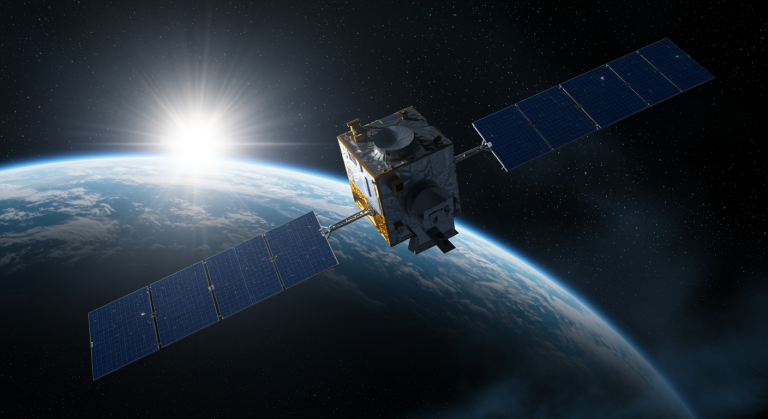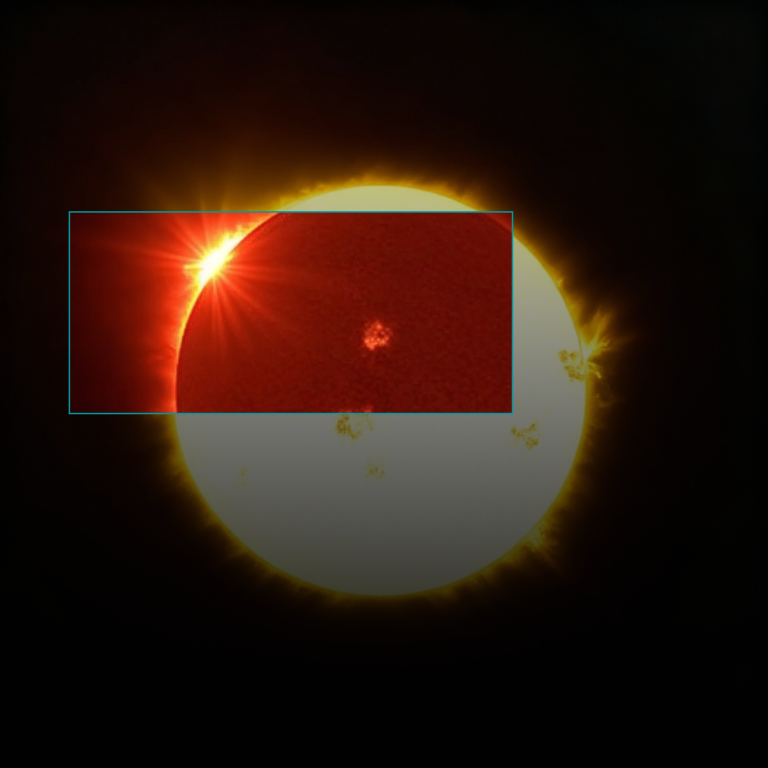The first Short-Wave Infrared (SWIR) blog series covered the fundamentals and diverse industrial applications such as agriculture, food production, pharmaceuticals, electronics, and also space exploration which enabled advanced material analysis, quality control and remote sensing. In the second blog, we talk about how the SWIR imaging plays a crucial role in public safety and defense, as one of the key technologies in the aid for rescue and protection. We performed several tests ourselves and tested the viability of SWIR imaging for multiple use-cases.
One such application that stands out is the use of SWIR imaging in fire rescue operations. Fires are chaotic, dangerous environments where visibility is often reduced to zero due to thick smoke and intense heat. Traditional visible-light cameras and even thermal imaging systems can struggle in these conditions. SWIR imaging, however, offers a unique solution, enabling firefighters to see through smoke, localize fires, and navigate hazardous environments with greater precision.
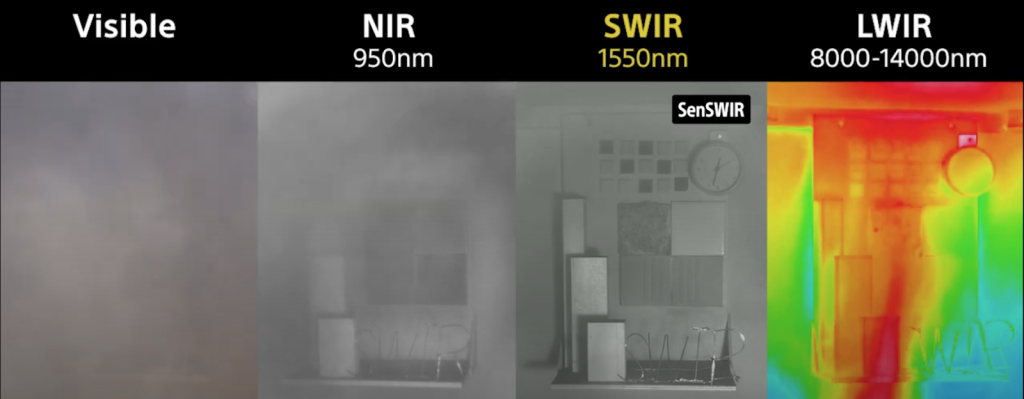
One of the most significant challenges in firefighting is the dense smoke that accompanies fires. Smoke scatters visible light, rendering traditional cameras useless and leaving firefighters blind in hazardous environments. SWIR imaging, operating in the 1 to 2.7 μm wavelength range, has a remarkable ability to penetrate smoke. This is because SWIR wavelengths are less affected by the scattering effects of smoke particles, allowing cameras to “see” through the obscurity.
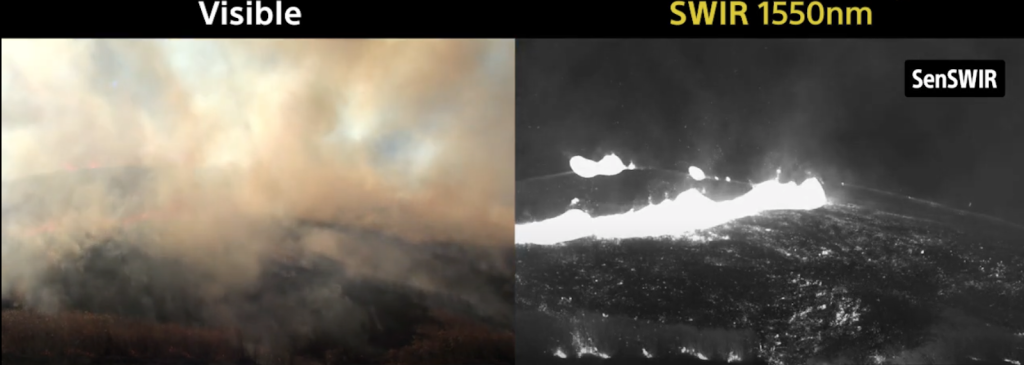
This capability is a game-changer for fire rescue teams. SWIR cameras mounted on drones, helmets, or handheld devices can provide real-time imagery of the fire scene, helping firefighters navigate through smoke-filled buildings, locate victims, and identify safe exit routes. This not only improves the efficiency of rescue operations but also enhances the safety of both firefighters and those they are trying to save. The fire brigade from the Public Fire Department of the City of Osijek was happy to volunteer in the SWIR visibility through smoke experiment. Many thanks for this, and all the hard work that comes with the job.
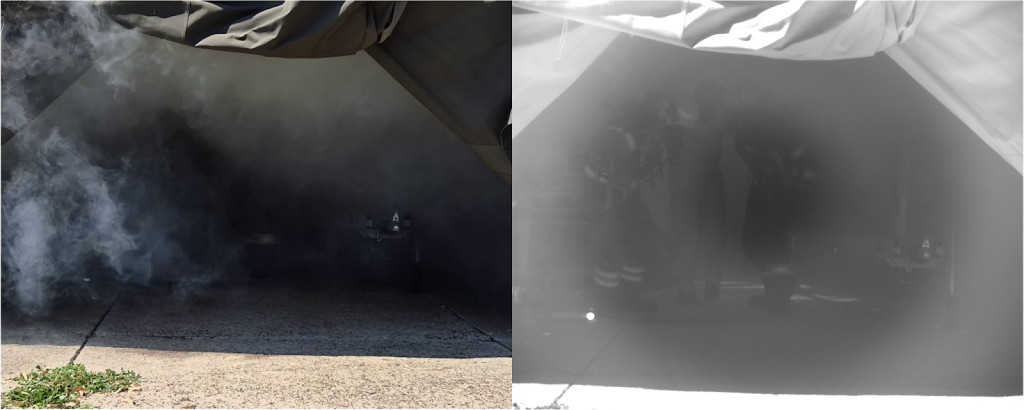
In addition to seeing through smoke, SWIR imaging can help localize the source of a fire. Fires emit radiation across a broad spectrum, including the SWIR range. By detecting this radiation, SWIR cameras can identify hotspots and the origin of the fire, even in complex environments. This is particularly useful in large-scale fires, such as wildfires or industrial fires, where the fire’s core may be obscured by smoke or debris.
For example, SWIR-equipped drones can fly over a wildfire, mapping the fire’s spread and identifying areas of intense heat. This information allows firefighting teams to allocate resources more effectively, targeting the most critical areas and preventing the fire from spreading further. In structural fires, SWIR imaging can help firefighters locate hidden flames within walls or ceilings, reducing the risk of re-ignition and ensuring the fire is fully extinguished.
In the dynamic and often chaotic environments of military and tactical operations, visibility can be severely compromised by smoke grenades, which are designed to obscure vision and create cover. As in the fire smoke, SWIR imaging also penetrates smoke from smoke grenades, and in the same manner, provides insight into the scene behind the smoke. This capability is invaluable for tactical teams, enabling them to maintain situational awareness, navigate safely, and execute missions effectively, even in the most obscured conditions. We tested this ourselves with the smoke grenades inside an abandoned building during the day, and saw for ourselves that SWIR imaging doesn’t just enhance vision—it can transform the battlefield.

One of the most compelling defense applications of SWIR imaging is its ability to detect camouflaged personnel and equipment—a capability that traditional visible-light cameras simply cannot match. Imagine a scenario where a soldier in a camouflage uniform blends seamlessly into a grassy field in visible light, but in SWIR, they stand out clearly. This is the power of SWIR imaging, and it’s revolutionizing the way modern militaries approach surveillance, reconnaissance, and threat detection. See the next picture, how the camouflage from one of our teammates is stripped in SWIR.

Camouflage is designed to deceive the human eye and visible-light imaging systems by mimicking the colors and patterns of the surrounding environment. In the visible spectrum, a well-camouflaged soldier or vehicle can become nearly invisible, especially in natural settings like forests, grasslands, or desert terrain. This poses a significant challenge for defense forces, as it limits their ability to detect and respond to potential threats.
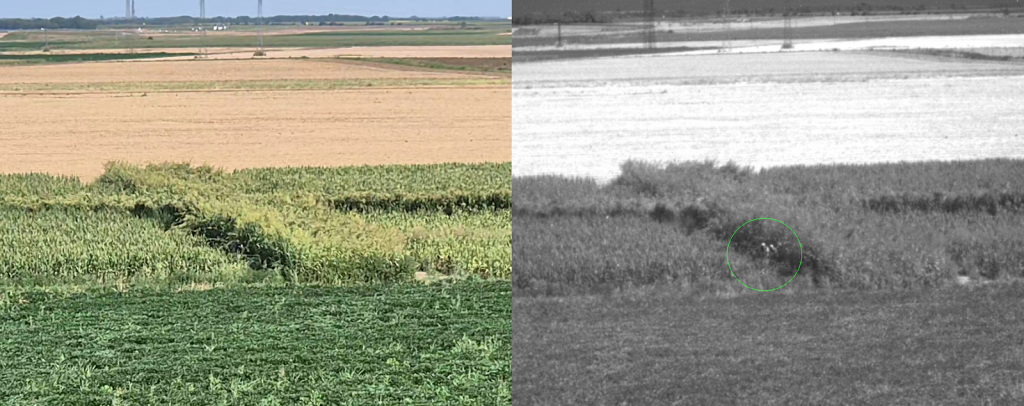
In the SWIR wavelength range, materials that appear similar in visible light often have distinct reflective properties. For example, the dyes and fabrics used in camouflage uniforms may reflect visible light in a way that matches the surrounding foliage, but they behave differently under SWIR light. Vegetation, such as grass or leaves, typically reflects SWIR light strongly, while many synthetic materials used in camouflage absorb it. This creates a stark contrast between the camouflaged object and its background in SWIR imagery, making it easier to detect.
In practical terms, this means that a soldier wearing camouflage in a grassy field might be nearly invisible in a visible-light photo but will stand out clearly in a SWIR image. This capability is invaluable for military operations, where detecting hidden threats can mean the difference between mission success and failure. That is why the camouflaged team in the tall grass field were nearly invisible in the visible spectrum, whereas in SWIR you can see nice white outfits and helmets moving through the vegetation.
The last example is the SWIR imaging for mine detection in vegetation in a plastic housing, such as a PFM-1 mine. While plastic and vegetation may appear similar in visible light, they have distinct reflective signatures in the SWIR spectrum. For instance, HDPE plastic reflects SWIR light differently than grass or leaves, creating a noticeable contrast in SWIR imagery. This allows SWIR cameras to identify plastic mine fragments even when they are scattered across a grassy field or partially buried in soil.
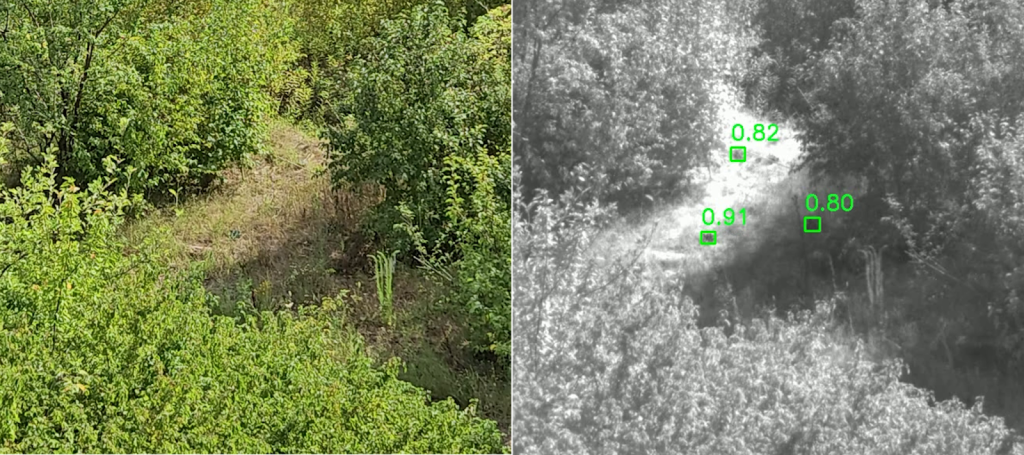
To make a compelling example, we made green HDPE plastic pieces, proportional to the size of PMF-1 mines, and threw them on a grass field. The photo comparison shows that in the visible light, the plastic blends almost perfectly with the grass, making detection nearly impossible. However, in the SWIR image, the plastic pieces stand out clearly, revealing their presence despite their camouflage. This capability is a game-changer for mine detection, offering a safer, faster, and more reliable method for locating these hidden threats.
This is the end of the second part of the SWIR blog series. Hope you enjoyed reading and now have a clear understanding of our R&D capabilities involving SWIR technology for public safety, firefighting, search and rescue, security, and defense applications. We hope you now have even more ideas for the possibilities for SWIR imaging, and perhaps find interesting use cases for your products or services. Don’t hesitate to contact us for any imaging questions.
References
[1] Screenshot from “SWIR Imaging Enhances Fire Zone Visibility: Visible Spectrum, NIR & LWIR Comparison | Sony Official” by Sony, available on YouTube at https://youtu.be/IHkPIOVJOCM
[2] Screenshot from “SWIR Imaging to Visualize Fire in the Mountains: Comparison with Visible Spectrum | Sony Official” by Sony, available on YouTube at https://youtu.be/vEbDk0AtdRs
Author: Marko Šprem, PhD, research scientist and photonics technologies expert.
His experience covers SWIR imaging, multispectral imaging, fluorescence microscopy, fiber optic communications, and sensors. You are welcome to contact Marko about any imaging applications via our Contacts page.

